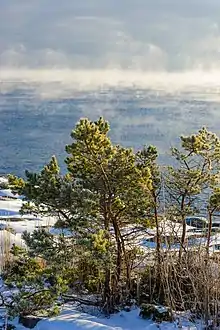Pinus sylvestris
Pinus sylvestris, the Scots pine (UK), Scotch pine (US) or Baltic pine,[2] is a species of tree in the pine family Pinaceae that is native to Eurasia. It can readily be identified by its combination of fairly short, blue-green leaves and orange-red bark.
| Pinus sylvestris | |
|---|---|
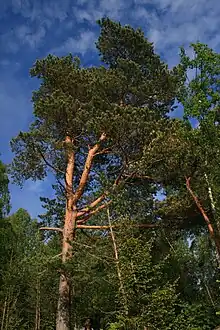 | |
| Scientific classification | |
| Kingdom: | Plantae |
| Clade: | Tracheophytes |
| Clade: | Gymnosperms |
| Division: | Pinophyta |
| Class: | Pinopsida |
| Order: | Pinales |
| Family: | Pinaceae |
| Genus: | Pinus |
| Subgenus: | P. subg. Pinus |
| Section: | P. sect. Pinus |
| Subsection: | P. subsect. Pinus |
| Species: | P. sylvestris |
| Binomial name | |
| Pinus sylvestris | |
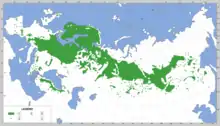 | |
| Distribution | |
Description
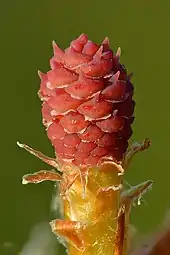
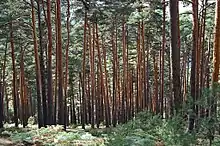
Pinus sylvestris is an evergreen coniferous tree growing up to 35 metres (115 feet) in height[3] and 1 m (3 ft 3 in) in trunk diameter when mature,[4] exceptionally over 45 m (148 ft) tall and 1.7 m (5+1⁄2 ft) in trunk diameter on very productive sites. The tallest on record is a tree over 210 years old growing in Estonia which stands at 46.6 m (153 ft).[5] The lifespan is normally 150–300 years, with the oldest recorded specimens in Lapland, Northern Finland over 760 years.[6][7][8][9]
The bark is thick, flaky and orange-red when young to scaly and gray-brown in maturity, sometimes retaining the former on the upper portion.[4][8][7] The habit of the mature tree is distinctive due to its long, bare and straight trunk topped by a rounded or flat-topped mass of foliage.[6][7][8][9]
The shoots are light brown, with a spirally arranged scale-like pattern. On mature trees the leaves ('needles') are a glaucous blue-green, often darker green to dark yellow-green in winter, 2.5–5 centimetres (1–2 inches) long and 1–2 millimetres (1⁄32–3⁄32 in) broad, produced in fascicles of two with a persistent gray 5–10 mm (1⁄4–3⁄8 in) basal sheath. On vigorous young trees the leaves can be twice as long, and occasionally occur in fascicles of three or four on the tips of strong shoots. Leaf persistence varies from two to four years in warmer climates, and up to nine years in subarctic regions. Seedlings up to one year old bear juvenile leaves; these are single (not in pairs), 2–3 cm (3⁄4–1+1⁄4 in) long, flattened, with a serrated margin.[6][8][9]
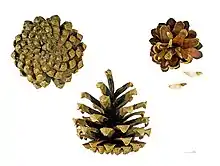

The seed cones are red at pollination, then pale brown, globose and 4–8 mm (5⁄32–5⁄16 in) in diameter in their first year, expanding to full size in their second year, pointed ovoid-conic, green, then gray-green to yellow-brown at maturity, 3–7.5 cm (1+1⁄8–3 in) long. The cone scales have a flat to pyramidal apophysis (the external part of the cone scale), with a small prickle on the umbo (central boss or protuberance). The seeds are blackish, 3–5 mm (1⁄8–3⁄16 in) in length with a pale brown 12–20 mm (1⁄2–13⁄16 in) wing and are released when the cones open in spring 22–24 months after pollination. The pollen cones are yellow, occasionally pink, 8–12 mm (5⁄16–15⁄32 in) long; pollen release is in mid to late spring.[6][8]
Varieties
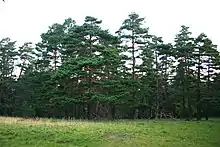
Over 100 Pinus sylvestris varieties have been described in the botanical literature, but only three or four are now accepted.[10] They differ only minimally in morphology, but with more pronounced differences in genetic analysis and resin composition. Populations in westernmost Scotland are genetically distinct from those in the rest of Scotland and northern Europe, but not sufficiently to have been distinguished as separate botanical varieties. Trees in the far north of the range were formerly sometimes treated as var. lapponica, but the differences are clinal and it is not genetically distinct.[6][7][11][12][13][14][15][16][17][18]
| Image | Varieties | Description | Distribution |
|---|---|---|---|
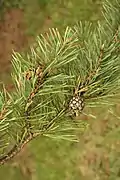 | Pinus sylvestris var. sylvestris L., 1753 | Described above. | The bulk of the range, from Scotland and Spain to central Siberia. |
 | Pinus sylvestris var. hamata Steven | Foliage more consistently glaucous all year, not becoming duller in winter; cones more frequently with a pyramidal apophysis. | The Balkans, northern Turkey, Crimea, and the Caucasus. |
 | Pinus sylvestris var. mongolica Litv. | Foliage duller green, shoots gray-green; leaves occasionally up to 12 cm long. | Mongolia and adjoining parts of southern Siberia and northwestern China. |
 | Pinus sylvestris var. nevadensis D.H.Christ. | (not considered distinct from var. sylvestris by all authors) Kalenicz. Ex Kom. Cones often with thicker scales, but doubtfully distinguishable on morphology. | The Sierra Nevada in southern Spain and possibly other Spanish populations |
 | Pinus sylvestris var. cretacea Kalenicz. ex Kom. | From border regions between Russia and Ukraine.[19] | |
Names
Before the 18th century, the species was more often known as Scots fir or Scotch fir. Another, less common name is European redwood.[2]
The timber from it is also called red deal[20] or yellow deal, the name "deal" being adopted from an archaic unit of volume used to measure wood.
Distribution and habitat
Pinus sylvestris is the only pine native to northern Europe,[21][22] ranging from Western Europe to Eastern Siberia, south to the Caucasus Mountains and Anatolia, and north to well inside the Arctic Circle in Fennoscandia. In the north of its range, it occurs from sea level to 1,000 m (3,300 ft), while in the south of its range it is a mountain tree, growing at 1,200–2,600 m (3,900–8,500 ft) altitude.[6][7][8][11]
The species is mainly found on poorer, sandy soils, rocky outcrops, peat bogs or close to the forest limit. On fertile sites, the pine is out-competed by other tree species, usually spruce or broad-leaved trees.[23]
Britain and Ireland
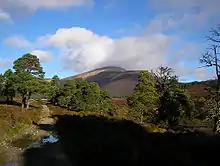
The tree spread across Britain and Ireland after the Last Glacial Maximum. Pollen records show that pine was present locally in southern England by 9,000 years ago having entered from northeast France and that it had spread as far north as the Lake District and North Pennines 500 years later.
It was present in Ireland over 8,800 years ago but absent from Wales at that time which suggests that the pine in Ireland had a separate Iberian origin or contained surviving populations, although evidence towards its survival is lacking.[14] Pine expanded into Scotland between 8,000 and 8,500 years ago either from an independent refuge, from Scandinavia (via Doggerland) or from Ireland. As the climate warmed it became extinct from most of Britain and Ireland around 5,500 years ago except in Scotland, Kielder in England and The Burren in County Clare, Ireland.
The Irish and western Scottish populations went through a massive decline around 4,000 years ago which ultimately led to the practical extinction of the Irish population between 2,000 and 1,000 years ago. It was replaced by large areas of blanket bog in western Scotland and Ireland though the reasons for its decline and extinction in England are not clear, but it may have been influenced by human activities.[24]
In Britain it now occurs naturally only in Scotland. Historical and archaeological records indicate that it also occurred in Wales and England until about 300–400 years ago, becoming extinct there due to over-exploitation and grazing; it has been re-introduced in these countries. Similar historical extinction and re-introduction applies to Ireland, Denmark and the Netherlands.[8][11][9][25] Whether it truly became extinct in England is unknown. It has been speculated that it may have survived wild long enough for trees used in cultivation in England to derive from native (rather than imported) sources.[26] Shakespeare (in Richard II) was familiar with the species in the 1590s, as was Evelyn in the early 1660s (Sylva), both around the time when the pine was thought to become extinct in England, but when landowners were also beginning ornamental and forestry planting.[26]
The pine formed much of the Caledonian Forest, which once covered much of the Scottish Highlands. Overcutting for timber demand, fire, overgrazing by sheep and deer, and even deliberate clearance to deter wolves have all been factors in the decline of this once great pine and birch forest. Only comparatively small areas – 17,000 hectares (42,000 acres), only just over 1% of the estimated original 1,500,000 ha (3,700,000 acres)[27] – of this ancient forest remain, the main surviving remnants being at Abernethy Forest, Glen Affric, Rothiemurchus Forest, and the Black Wood of Rannoch. Plans are currently in progress to restore at least some areas and work has started at key sites.[8][9]
Ecology
It forms either pure forests or mixes with Norway spruce, common juniper, silver birch, European rowan, Eurasian aspen and other hardwood species. In central and southern Europe, it occurs with numerous additional species, including European black pine, mountain pine, Macedonian pine, and Swiss pine. In the eastern part of its range, it occurs with Siberian pine, among others.[7][8]
In 2020, black spot needle blight was found on hundreds of Pinus sylvestris var. mongolica trees in four forest farms in northeastern China. It first appeared on the upper part of the needles, and then the needles became withered and gradually showed light black spots, although they still remained green. As the fungal disease progressed, the needles eventually died and turned gray with many dark black spots. The fungus was identified as Heterotruncatella spartii (within the family Sporocadaceae) based on morphology and molecular methods.[28]
Uses
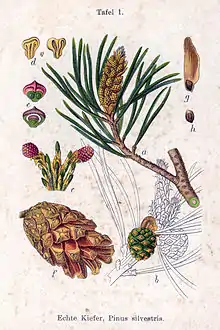

Pinus sylvestris is an important tree in forestry. The wood is used for pulp and sawn timber products. A seedling stand can be created by planting, sowing, or natural regeneration. Commercial plantation rotations vary between 50 and 120 years, with longer rotations in northeastern areas where growth is slower.
In Scandinavian countries, the pine was used for making tar in the preindustrial age. Some active tar producers still exist, but that industry has almost ceased.[9][12] The pine has also been used as a source of rosin and turpentine.
The wood is pale brown to red-brown, and used for general construction work. It has a dry density around 470 kg/m3 (varying with growth conditions), an open porosity of 60%, a fibre saturation point of 0.25 kg/kg, and a saturation moisture content of 1.60 kg/kg.[12] The pine fibres are used to make the textile known as vegetable flannel,[29] which has a hemp-like appearance, but with a tighter, softer texture.[30]
The pine has also been widely planted in New Zealand and much of the colder regions of North America; it was one of the first trees introduced to North America, in about 1600.[31] It is listed as an invasive species in some areas there, including Ontario,[32] Michigan.[33] It has been widely used in the United States for the Christmas tree trade, and was one of the most popular Christmas trees from the 1950s through the 1980s. It remains popular for that usage, though it has been eclipsed in popularity, by such species as Fraser fir, Douglas-fir, and others. Despite its invasiveness in parts of eastern North America, the pine does not often grow well there, partly due to climate and soil differences between its native habitat and that of North America, and partly due to damage by pests and diseases; the tree often grows in a twisted, haphazard manner if not tended to (as they are in the Christmas tree trade).[7][21] The pines may be killed by the pine wood nematode, which causes pine wilt disease. The nematode most often attacks trees that are at least ten years old and often kills trees it infects within a few weeks.[34]
Previously, the pine was grown in and used extensively by the coal mining regions of Flanders, Belgium. It was used to fortify tunnels, primarily because it would make a cracking sound when in need of replacement. Large patches of forest, mostly containing the species, are still scattered over the countryside.
Cultivars
Several cultivars are grown for ornamental purposes in parks and large gardens, of which 'Aurea',[35] 'Beuvronensis',[36] 'Frensham',[37] and 'Gold Coin'[38] have gained the Royal Horticultural Society's Award of Garden Merit.[39]
In culture
The Scots pine is the plant badge of Clan Gregor. It is the national tree of Scotland.[40]
Gallery
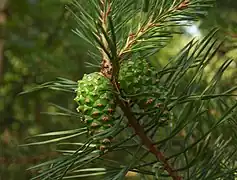 Leaves and cones, Poland
Leaves and cones, Poland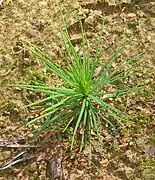 Seedling with flattish, unfascicled leaves
Seedling with flattish, unfascicled leaves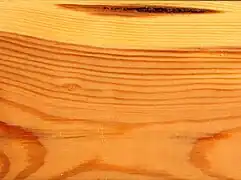 Wood
Wood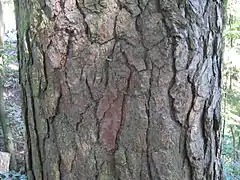 Bark on a mature specimen
Bark on a mature specimen Looking up in the branch structure
Looking up in the branch structure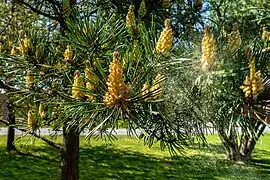 Pine releasing pollen on a windy day in Sweden
Pine releasing pollen on a windy day in Sweden
See also
References
- Gardner, M. (2013). "Pinus sylvestris". IUCN Red List of Threatened Species. 2013: e.T42418A2978732. doi:10.2305/IUCN.UK.2013-1.RLTS.T42418A2978732.en. Retrieved 19 November 2021.
- Bispham, J. (2015). "Architectural Timber – History and Conservation". In Taylor, J. (ed.). The Building Conservation Directory (22nd ed.). Tisbury: Cathedral Communications. pp. 123–126. ISBN 978-1-900915-71-7. OCLC 931417684.
- Rushforth, K. (1986) [1980]. Bäume [Pocket Guide to Trees] (in German) (2nd ed.). Bern: Hallwag AG. ISBN 978-3-444-70130-6.
- Marinich, A.; Powell, K. (2017). Scots Pine: Best Management Practices in Ontario (PDF). Peterborough, Ontario: Ontario Invasive Plant Council.
- Oidermaa, J.-J., ed. (9 February 2016). "Eesti kõrgeim mänd osutus hiiglaseks ka ülejäänud maailmas" [Estonia's tallest pine turned out to be a giant in the rest of the world as well]. ERR Novaator (in Estonian). Tallinn: Eesti Rahvusringhääling. Retrieved 9 February 2016.
- Farjon, A. (2005). Pines: Drawings and descriptions of the genus Pinus (2nd ed.). Leiden: Koninklijke Brill. ISBN 978-90-04-13916-9. OCLC 59279728. OL 9084955M.
- Earle, Christopher J., ed. (2018). "Pinus sylvestris". The Gymnosperm Database.
- Featherstone, A. W. "Species profile: Scots pine". Forres: Trees for Life. Archived from the original on 26 February 2014.
- Steven, H. M.; Carlisle, A. (1959). The Native Pinewoods of Scotland. Edinburgh: Oliver and Boyd. OCLC 1148550. OL 6267106M.
- "The Plant List v1.1: Pinus sylvestris". Royal Botanic Gardens Kew and Missouri Botanic Garden. 2013. Retrieved 22 March 2019.
- Mirov, N. T. (1967). The Genus Pinus. New York: Ronald Press Company. OCLC 712344.
- Pravdin, L. F. (1969) [1964]. Scots Pine: Variation, Intraspecific Taxonomy, and Selection. Jerusalem: Israel Program for Scientific Translations. OCLC 121486.
- Langlet, O. (1959). "A Cline or not a Cline – a Question of Scots Pine" (PDF). Silvae Genetica. 8 (1): 13–22.
- Kinloch, B. B.; Westfall, R. D.; Forrest, G. I. (1986). "Caledonian Scots Pine: Origins and Genetic Structure". The New Phytologist. 104 (4): 703–729. doi:10.1111/j.1469-8137.1986.tb00671.x. JSTOR 2433046. PMID 33873854.
- Szmidt, A. E.; Wang, X.-R. (1993). "Molecular systematics and genetic differentiation of Pinus sylvestris (L.) and P. densiflora (Sieb. et Zucc.)". Theoretical and Applied Genetics. 86 (2–3): 159–165. doi:10.1007/BF00222074. PMID 24193455. S2CID 10888339.
- Prus-Glowacki, W.; Stephan, B. R. (1994). "Genetic variation of Pinus sylvestris from Spain in Relation to Other European Populations". Silvae Genetica. 43 (1): 7–14.
- Goncharenko, G. G.; Silin, A. E.; Padutov, V. E. (1995). "Intra- and interspecific genetic differentiation in closely related pines from Pinus subsection Sylvestres (Pinaceae) in the former Soviet Union". Plant Systematics and Evolution. 194 (1/2): 39–54. doi:10.1007/BF00983215. JSTOR 23642988. S2CID 12560701.
- Sinclair, W. T.; Morman, J. D.; Ennos, R. A. (1999). "The postglacial history of Scots pine (Pinus sylvestris L.) in western Europe: evidence from mitochondrial DNA variation". Molecular Ecology. 8 (1): 83–88. doi:10.1046/j.1365-294X.1999.00527.x. S2CID 84168134.
- "Красная Книга России | Red Book of Russia. Pinus Sylvestris L. Var. Cretacea Kalenicz. Ex Kom". biodat.ru. Retrieved 21 March 2016.
- "Red Deal/European Red Wood". Tralee: Adanack. Retrieved 24 October 2022.
- Sullivan, J. (1993). "Pinus sylvestris". Fire Effects Information System. Fire Sciences Laboratory, Rocky Mountain Research Station, United States Department of Agriculture. Retrieved 20 May 2023.
- "Scots Pine (Pinus sylvestris)". A–Z of British Trees. Grantham: the Woodland Trust. Retrieved 25 June 2022.
- Mátyás, C.; Ackzell, L.; Samuel, C. J. A. (2004). Scots pine – Pinus sylvestris (PDF). EUFORGEN Technical Guidelines for Genetic Conservation and Use. Rome: International Plant Genetic Resources Institute. p. 6. ISBN 978-92-9043-661-4 (PDF).
{{cite book}}: Check|archive-url=value (help) - Milner, E. (2011). Trees of Britain and Ireland. London: the Natural History Museum. pp. 15, 120. ISBN 978-0-565-09295-5. OCLC 751745667.
- Carlisle, A.; Brown, A. H. F. (1968). "Biological Flora of the British Isles: Pinus sylvestris L.". Journal of Ecology. 56 (1): 269–307. doi:10.2307/2258078. JSTOR 2258078.
- Edlin, H. L. (1970). Trees, Woods and Man. The New Naturalist: A Survey of British Natural History (3rd ed.). London: Collins. ISBN 978-0-00-213230-5. OCLC 1835850. OL 38560280M.
- "Scots pine facts and information". Forres: Trees for Life. Retrieved 25 June 2022.
- Wang, S.-R.; Zhang, H.; Chen, Y.-Z.; Zhang, Y.-D.; Li, D.-B.; Huang, Y.; Zhang, G.; Yang, J. (2022). "First Report of Black Spot Needle Blight of Pinus sylvestris var. mongolica Litv. Caused by Heterotruncatella spartii in China". Plant Disease. 106 (8): 2256. doi:10.1094/PDIS-12-21-2667-PDN. PMID 35108070. S2CID 246487193.
- "Vegetable flannel". Webster's 1913 Dictionary. Retrieved 18 August 2014.
- Cole, G. S. (1892). A Complete Dictionary of Dry Goods and History of Silk, Cotton, Linen, Wool, and other Fibrous Substances, etc etc (revised ed.). Chicago: W. B. Conkey Company. pp. 365–366. OCLC 401856. OL 7231038M.
- Kershner, B.; Mathews, D.; Nelson, G.; Spellenberg, R.; Purinton, T.; Block, A.; Moore, G.; Thieret, J. W. (2008). National Wildlife Federation Field Guide to Trees of North America. New York: Sterling Publishing Company. p. 67. ISBN 978-1-4027-3875-3. OCLC 705626973. OL 11637505M.
- "Invasive Ontario Plants". Protect Our Water and Environmental Resources. Archived from the original on 26 April 2012. Retrieved 17 December 2011.
- "Species found in Michigan". Early Detection and Distribution Mapping System. Center for Invasive Species and Ecosystem Health at the University of Georgia. Retrieved 17 December 2011.
- Gleason, M.; Linit, M.; Zriba, N.; Donald, P.; Tisserat, N.; Giesler, L. (2000). Edwards, E. (ed.). Pine Wilt: A Fatal Disease of Exotic Pines in the Midwest (PDF). Sustainable Urban Landscapes. Iowa State University. SUL 9 (PDF).
{{cite book}}: Check|archive-url=value (help) - "RHS Plantfinder - Pinus sylvestris (Aurea Group) 'Aurea'". Retrieved 30 April 2018.
- "RHS Plant Selector – Pinus sylvestris 'Beuvronensis'". Retrieved 6 February 2021.
- "RHS Plantfinder - Pinus sylvestris 'Frensham'". Retrieved 30 April 2018.
- "RHS Plantfinder - Pinus sylvestris 'Gold Coin'". Retrieved 25 April 2018.
- "AGM Plants - Ornamental" (PDF). Royal Horticultural Society. July 2017. p. 78. Retrieved 30 April 2018.
- Rick Steves Scotland (second edition) By Rick Steves
External links
- Eichhorn, Markus (October 2011). "The Scots Pine". Test Tube. Brady Haran for the University of Nottingham.
- Pinus sylvestris - distribution map, genetic conservation units and related resources. European Forest Genetic Resources Programme (EUFORGEN)

